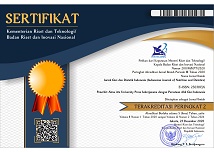Snack bar formulation with beetroot (Beta vulgaris. L) flour as iron sources for adolescent girls
Abstract
ABSTRAK
Latar Belakang: Prevalensi anemia di Indonesia pada remaja putri meningkat dari 37.1% menurut Riskesdas 2013 menjadi 48.9% pada tahun 2018. Snackbar merupakan cemilan yang digemari oleh remaja. Penambahan tepung umbi bit pada snackbar sebagai sumber zat besi diharapkan menjadi alternatif cemilan sehat bagi remaja putri.
Tujuan: Untuk mengembangkan formula snack bar.
Metode: Penelitian ini menggunakan desain eksperimental. Formulasi terdiri atas dua tahap yaitu tahap pertama menentukan formula terbaik tanpa penambahan tepung umbi bit. Tahap kedua yaitu formulasi dengan penambahan tepung umbi bit dengan tiga taraf yang berbeda yang terdiri atas F1 40 gram, F2 50 gram, F3 60 gram. Analisis kandungan zat gizi dilakukan melalui uji proksimat dan spektrofotometri.
Hasil: Formula terbaik adalah F1 dengan penambahan tepung umbi bit sebanyak 40 gram. F1 mengandung 11,99% protein; 10,62% lemak; 53,04% karbohidrat; 4,76 mg zat besi (32% memenuhi AKG remaja putri dan 21,6% ALG kelompok umum), dengan total energi sebesar 355,75 kkal/100g.
Kesimpulan: Tepung umbi bit dapat digunakan untuk meningkatkan kandungan zat gizi snack bar, dimana dapat membantu memenuhi kebutuhan zat gizi remaja putri khususnya kebutuhan zat besi. Untuk penelitian selanjutnya, dapat ditambahkan pangan sumber protein hewani agar dapat meningkatkan penyerapan zat besi.
KATA KUNCI: remaja; snackbar; tepung; umbi bit; zat besi
ABSTRACT
Background: In Indonesia, the prevalence of anemia in adolescent girls increased from 37.1% (Riskesdas 2013) to 48.9% (Riskesdas 2018). A snack bar is one of the snacks favored by adolescents. The addition of beetroot flour as a source of iron to snack bars is expected to be an alternative healthy snack for adolescent girls.
Objectives: The objective of this study was to develop a snack bar formulation
Methods: This study used an experimental design. The snack bar was made in two stages. The first stage was to determine the best formula without adding beetroot flour, and the second stage was adding beetroot flour in the following amounts: 40 g (F1), 50 g (F2), and 60 g (F3). Analysis of nutrient content was carried out through the proximate test and spectrophotometry.
Results: The best formula was (F1), i.e., administering 40 g of beetroot flour. F1 contained 11.99% of protein, 10.62% of fat, 53.04% of carbohydrates, and 4.76 mg of iron (32% fulfilling Fe needed by adolescent girls based on the Dietary Reference Intake and 21.6% of the Reference Intake for the general category), with a total energy of 355.75 kcal/100 g.
Conclusions: Beetroot flour could be used to improve nutrient profiles of snack bars, which could be used to fulfill the nutrient needs of adolescents, especially for iron. For the next research, a new formulation is needed by adding animal protein sources to increase iron absorption.
KEYWORDS: adolescent; beetroot; flour; iron; snack bar
Keywords
Full Text:
PDFReferences
Pardede N. 2002. Adolescence in the Development of Children and Adolescents. Jakarta (ID): Sagung Seto.
World Health Organization. Adolescent Nutrition-A Review of The Situation Selected South-East Asian countries 2006.
World Health Organization. Anemia among adolescent and young adult women in Latin America and the Caribbean-A cause for concern 2010.
Ministry of Health. 2018. Basic Health Research Results 2018. Jakarta (ID): Agency for Health Research and Development.
Balarajan Y, Ramakrishnan U, Özaltin E, Shankar AH, Subramanian SV. 2011. Anemia in low-income and middle-income countries. Lancet. 1-13.
Agrawal S, Misra R, Aggarwal A. 2006. Anemia in rheumatoid arthritis: high prevalence of iron-deficiency anemia in Indian patients. Rheumatol Int. 26: 1091–1095.
Kaur K. 2014. Anemia ‘a silent killer’ among women in India: Present scenario. Euro J Zool Res. 3 (1):32-36.
Astawan, M. 2009. Healthy with nuts and seeds. Bogor: Penebar Swada.
Sari DYE, Angkasa D, Swamilaksita PD. 2017. Acceptance and nutritional value of vegetable and fruit modified snack bars for young women. Jurnal Gizi. 6(1):1-11.
Ministry of Health. 2016. Indonesian Health Profile. Jakarta: Depkes RI
Ikawati K, Rokhana. 2018. Pengaruh buah bit (beta vulgaris) terhadap indek eritrosit pada remaja putri dengan anemia. JNPH, 6:(2).
Penggalih MHST, dkk. 2021. Pengaruh pemberian jus bit terfortifikasi FeSo4 instan (Jus Beefe) dalam menanggulangi anemia atlet remaja putri. J. Teknol. dan Industri Pangan. 32(2): 107-115.
Janah LN. 2017. Torsang snack bar formulation: banana flour and green beans with the addition of torbangun (coleus amboinicus lour) as an effort to relieve premenstrual syndrome [skripsi]. Bogor (ID): Institut Pertanian Bogor.
Meilgaard, et al., 2000. Sensory evaluation techniques. Boston: CRC.
PT Otsuka. 2019. Nutrition fact of soyjoy variants. PT Otsuka Amerta Indah, Pasuruan. Jawa timur.
Badan Standarisasi Nasional. 1996. Syarat Mutu Makanan Diet Kontrol Berat
Badan. SNI 01-4216-1996. BSN, Jakarta.
Winarno FG. 2008. Food Chemistry and Nutrition. Jakarta (ID): M Brio Press.
Natalia D. 2010. Physicochemical properties and glycemic index of various snack products [skripsi]. Bogor (ID): Institut Pertanian Bogor.
Fatkurahman. R.,Windi. A., dan Basito. 2012. Sensory characteristics and physicochemical properties of cookies with the substitution of black rice bran (Oryza Sativa l.) and corn flour (zea mays L.). Jurnal teknosains pangan, Universitas Sebelas Maret 1(2) :82-90.
Fahimah, Margawati A, Fitranti DY. 2017. Hubungan konsumsi asam lemak omega-3, aktivitas fisik dan persen lemak tubuh dengan tingkat dismenore pada remaja. Journal of Nutrition College. 6(4): 268-276.
Brody T. 1999. Nutrition Biochemistry. California (USA): Academic Pres
Indonesian Pediatric Society. 2013. Nutrisi Pada Remaja.
Perwita ES, dkk. 2021. Proporsi tepung kacang merah (Phaseolus vulgaris L.) dan bubuk daun kelor (Moringa oleifera L) terhadap sifat fisik organoleptic snack bar labu kuning. JTB. 10(2): 303-313.
Septiani, V. E. 2016. Pembuatan Snack Bar Bebas Gluten dari Bahan Baku Tepung Mocaf dan Tepung Beras Pecah Kulit. Nutrition Jurnal.
National Agency of Drug and Food Control. 2016. Regulation of the Head of the Food and Drug Supervisory Agency Number 09 of 2016 concerning Nutrition Label Reference. Jakarta (ID): BPOM RI.
DOI: http://dx.doi.org/10.21927/ijnd.2021.9(3).111-117
Refbacks
- There are currently no refbacks.

This work is licensed under a Creative Commons Attribution-ShareAlike 4.0 International License.
Indonesian Journal of Nutrition and Dietetics (IJND) indexed by:
 View My Stats
View My Stats



12.png)


























